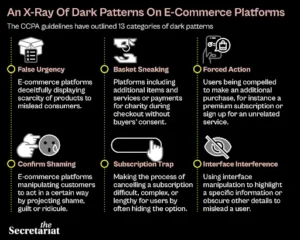Introduction
- The study by the Advertising Standards Council of India (ASCI) has found that 52 of the top 53 apps have deceptive UI (user interface)/UX (user experience) practices that can mislead or trick users into doing something they originally did not intend or want to do.
- The deceptive patterns (dark patterns) discovered include privacy deception, interface interference, drip pricing, and false urgency.
- Privacy deception emerged as the most prevalent deceptive pattern, observed in 79% of the apps analysed, followed by interface interference (45%), drip pricing (43%), and false urgency (32%).
What are Dark Patterns?
- Dark patterns, also known as deceptive patterns, are unethical business strategies integrated into digital interfaces designed to manipulate or mislead users.
- These tactics exploit cognitive and behavioral biases, leading users to make choices that may not be in their best interest, often resulting in financial loss, compromised privacy, or other negative outcomes.
- The term “dark pattern” was coined by Harry Brignull in 2010 to describe such strategies used by websites and apps.

Types of Dark Patterns
False Urgency
-
- Definition: Creating a false sense of urgency or scarcity to prompt immediate action from users.
- Examples: Platforms showing “Only 2 left!” when the stock is ample, or falsely inflating the popularity of a product.
Basket Sneaking
-
- Definition: Adding extra items to a user’s cart during checkout without their explicit consent.
- Examples: Automatically including a subscription service or donation in the cart, requiring users to manually remove them.

Confirm Shaming
-
- Definition: Guilt-tripping users into making a decision by using emotionally manipulative language.
- Examples: Phrases like “No, I prefer to stay ignorant” when declining an email subscription.
Forced Action
-
- Definition: Compelling users to take actions they may not desire, such as signing up for a service to access content.
- Examples: Requiring account creation to view a free resource.
Subscription Traps
-
- Definition: Making it easy to subscribe but difficult to cancel, often by obscuring the cancellation process.
- Examples: Hiding the cancellation option deep within settings or requiring multiple steps to cancel.
Interface Interference
-
- Definition: Manipulating the user interface to highlight specific information while obscuring other relevant details.
- Examples: Using contrasting colors to draw attention to a “buy now” button while making the “cancel” option less visible.
Bait and Switch
-
- Definition: Advertising one product or service and delivering another, often of lower quality.
- Examples: Promoting a high-quality product in ads but delivering a subpar version upon purchase.
Drip Pricing
-
- Definition: Revealing hidden costs only after a user has started the checkout process.
- Examples: Advertising a low price initially, then adding mandatory fees during checkout.
Disguised Advertisement
-
- Definition: Presenting advertisements as user-generated content or editorial articles.
- Examples: Sponsored content that mimics user reviews or news articles without clear disclosure.
Nagging
-
- Definition: Overloading users with repetitive requests, information, or interruptions unrelated to their intended actions.
- Examples: Continuous pop-ups urging users to upgrade to premium services, as seen on platforms like YouTube.
Real-World Examples of Dark Patterns
- Amazon: Faced scrutiny in the EU for its complex cancellation process for Amazon Prime, leading to changes in 2022 to simplify the process.
- YouTube: Known for repetitive pop-ups urging users to subscribe to YouTube Premium.
- Indigo Airlines: Utilizes false urgency in seat booking and places the “skip” option in an obscure location on its app.
Concerns with Dark Patterns
Erosion of Consumer Autonomy
-
- Issue: Dark patterns manipulate consumers into making decisions they wouldn’t typically make, undermining their freedom of choice.
- Example: Platforms like Facebook have been criticized for using interface interference to make it difficult for users to find privacy settings, leading them to share more personal information than they would otherwise choose to.
Financial Losses
-
- Issue: Practices like drip pricing and basket sneaking result in unexpected costs, eroding consumer trust and financial well-being.
- Example: Many airline websites add charges for seat selection, insurance, and other services during the checkout process, which are only visible at the final stage of payment. This drip pricing tactic can lead to consumers paying much more than initially expected.
Privacy Violations
-
- Issue: Dark patterns such as confirm shaming pressure users into sharing more personal data than intended, violating their privacy rights.
- Example: Some apps use confirm shaming to push users into enabling location tracking by presenting the option to decline with negative phrasing like “Don’t show me relevant offers.” This tactic can result in users sharing location data against their will.
Psychological Impact
-
- Issue: These patterns can lead to emotional distress, frustration, and a sense of lost control over personal decisions.
- Example: Constant nagging through pop-ups urging users to upgrade to premium services, as seen on platforms like YouTube, can cause user frustration and anxiety, especially when the options to dismiss these prompts are limited.
Inhibition of Innovation
-
- Issue: Companies relying on dark patterns for quick gains may neglect genuine user-centric innovation.
- Example: Retail websites that use false urgency tactics, like countdown timers for deals, may focus more on short-term sales boosts rather than improving the overall user experience or product quality.
Social Backlash
-
- Issue: Negative publicity, especially amplified by social media, can damage a brand’s reputation when users share their negative experiences widely.
- Example: In 2022, the e-commerce giant Amazon faced widespread criticism on social media for its complex process to cancel Amazon Prime subscriptions, leading to a backlash that prompted changes in the cancellation process across Europe.
Distorted Market Competition
-
- Issue: Companies using dark patterns may gain unfair competitive advantages, harming those who adhere to ethical practices.
- Example: Subscription-based services that employ subscription traps can generate higher revenues by making it difficult for users to cancel, placing ethically run companies that make cancellation easy at a competitive disadvantage.
Regulatory Initiatives Against Dark Patterns
- European Union: Released guidelines under GDPR to help identify and avoid dark patterns on social media.
- United States: California’s amendments to the Consumer Privacy Act ban dark patterns that complicate opting out of data sales.
- United Kingdom: The CMA has flagged certain pressure-selling tactics as violations of consumer protection laws.
- India: The Department of Consumer Affairs issued guidelines under the Consumer Protection Act, 2019, specifically targeting dark patterns, enforced by the Central Consumer Protection Authority (CCPA).
Challenges in Regulating Dark Patterns with Examples
Lack of Specific Legislation
-
- Issue: Many countries do not have specific laws that directly address dark patterns. Instead, they rely on broader consumer protection laws, which may not adequately cover the nuances of these deceptive practices.
- Example: In India, while the Consumer Protection Act, 2019, addresses some aspects of misleading practices, it does not explicitly mention dark patterns. This can make it challenging to hold companies accountable for specific deceptive tactics, such as subscription traps or basket sneaking.
Complex Legal Definitions
-
- Issue: Determining what constitutes a dark pattern is often subjective and complex. The fine line between persuasive design and manipulation can make legal enforcement difficult.
- Example: In the European Union, despite the GDPR’s broad provisions, courts have faced challenges in distinguishing between aggressive marketing and illegal dark patterns, such as the use of subtle interface interference to obscure privacy settings.
Evolving Techniques
-
- Issue: Dark patterns are continuously evolving, with new tactics emerging as companies find innovative ways to influence user behavior. This constant evolution makes it difficult for regulatory frameworks to keep up.
- Example: Social media platforms frequently update their algorithms and user interfaces, introducing new dark patterns such as infinite scrolling or autoplay features that encourage prolonged engagement, making it hard for regulators to identify and address these new manipulative practices.
Resource Constraints
-
- Issue: Regulatory bodies often lack the resources—both financial and technical—to effectively monitor, investigate, and penalize companies using dark patterns.
- Example: In the United States, the Federal Trade Commission (FTC) has been criticized for its limited capacity to enforce actions against the widespread use of dark patterns in digital advertising, where companies frequently use drip pricing or disguised advertisements to mislead consumers.
Low Awareness and Reporting
-
- Issue: Consumers may not recognize when they are being manipulated by dark patterns, leading to underreporting of these practices. Without consumer reports, regulatory bodies have less evidence to take action.
- Example: Many users are unaware that they are victims of subscription traps—like when they sign up for a “free trial” and are automatically enrolled in a paid subscription with no easy way to cancel. This lack of awareness results in fewer complaints to consumer protection agencies, limiting their ability to act on these issues.
Read also: Understanding Quantum Computing Technology | UPSC
The Way Forward
Empowering Users
-
- Action: Provide tools, such as browser extensions, to help users identify and avoid dark patterns.
- Encouragement: Promote user education on dark patterns and establish clear channels for reporting deceptive practices.
- For instance, “Dark Patterns Tip Line,” a project by Princeton University that educates users on how to identify dark patterns and report them.
Promoting Industry Self-Regulation
-
- Action: Encourage companies to adopt ethical design practices and conduct regular audits to identify and eliminate dark patterns.
- Encouragement: Establish industry-wide ethical design guidelines and encourage transparency in digital interfaces.
- For instance, the European Union’s General Data Protection Regulation includes user rights awareness campaigns that inform consumers about their data protection rights, helping them recognize when they are being manipulated by dark patterns.
Emphasizing Ethical Design
-
- Action: Promote the use of a “conscious score” for apps to highlight ethical design practices, helping users make informed choices.
- Encouragement: Develop industry certifications or labels for apps that adhere to ethical design standards.
- For instance, the Digital Trust & Safety Partnership (DTSP) is an industry initiative where companies like Google, Facebook, and Twitter have committed to adhering to best practices for online safety and ethical design, which includes avoiding dark patterns.
Strengthening Enforcement
-
- Action: Provide the CCPA with adequate resources to monitor and address dark patterns effectively, ensuring consumer protection.
- For instance, the California Consumer Privacy Act (CCPA) empowers the California Attorney General to take action against companies using dark patterns to violate consumer rights, providing a model for robust enforcement mechanisms.
- Encouragement: Enhance collaboration between regulatory bodies, industry stakeholders, and consumer advocacy groups to tackle dark patterns.
- For instance, the UK’s Competition and Markets Authority (CMA) works closely with consumer groups and industry stakeholders to address issues related to dark patterns. They have initiated investigations and taken action against companies employing tactics like false urgency, setting a precedent for collaboration-driven enforcement.

